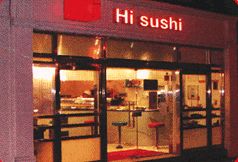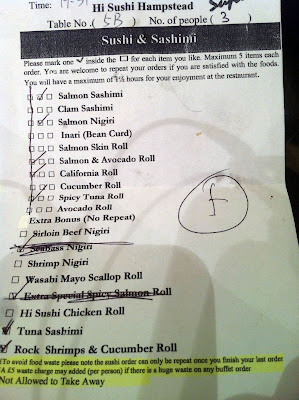With Heidi and Jack out today with a friend and Lucinda off doing whatever it is Lucinda does, Jazz and I had a morning to do a bit of local exploration.
The Crofts are part of a larger area on the western downslope from Hampstead known as Frognal. The area is bounded to the west and south by Platt's Lane and Finchley Road; to the north by West Heath Drive and Branch Hill; and to the east by Frognal (no lane or street or avenue -- just Frognal), which meanders down from Hampstead Village to Finchley Road, terminating near the Finchley Road & Frognal Overground Station.
The first settlement in Hampstead parish was in the Frognal area, probably where Frognal and Frognal Lane now meet. The name "Frognal" most likely was derived from the great number of frogs who dwelt here when it was marshy meadow and farmland. Substantial development in the area did not begin until the mid-1870s, after the Finchley Road & Frognal and Finchley Road rail stations opened and the toll gates on Finchley Road were taken down.
Jazz and I struck out to cover the area as best we could, recording some of our favorite bits. This is a survey, not an exhaustive catalog; it includes only things that I found interesting and that I could photograph without trespassing; and I have included only buildings that originally were intended as family homes (no churches, public buildings, or purpose-built flats). These and the many lovely homes and estates that I omitted because they were inaccessible or insufficiently distinct from their neighbors you will have to discover on your own wanderings. (Due to the size of the post and the number of photographs, I have broken it into several parts; future installments will cover properties in Branch Hill, upper Frognal, Redington Road and Templewood Avenue.)
 |
| 8 Heath Dr |
8 Heath Drive
The college I attended when I lived in London in 1985,
Westfield College of the University of London, was just down the street from this house at the corner of Kidderpore Avenue and Heath Drive (and only a few hundred yards from our home in Rosecroft Avenue). Westfield College merged with another college in 1989, however, and relocated to East London in 1992. The site has been occupied in part by King's College; the rest has been covered with a large, dull block of overpriced flats.
There is nothing of historical or architectural interest in this house, and I didn't give it much thought when we first walked past. But the view back across Heath Drive from Bracknell Gardens caught my eye. As you will no doubt surmise from some of the later entries, I am a sucker for turrets and cupolas, so a three-storey turret topped with a cupola will always put a house in the running, even (if the cupola is in desperate need of a new coat of paint).
 |
| 16 Bracknell Gardens |
The Huxley House, 16 Bracknell Gardens
Blue plaques denoting that a famous or historical figure once lived in a house are common in Hampstead. Indeed, the local paper once ran a cartoon showing a quizzical tourist debating whether to photograph a plaque stating, "The only house in Hampstead where no one famous ever lived." Most of the people so honored were, of course, British cultural or political figures, many from the 19th or early 20th centuries, whose names mean nothing to me. Not so with this house--although among the least interesting houses I saw today from an architectural perspective, I made a special point to pass by, for this was the house of Leonard Huxley and his brood of geniuses.
Leonard, of course, was the son of
T.H. Huxley, a biologist and contemporary of Darwin, who publicly championed Darwin's ideas (even as Darwin himself shied away from doing) and who published a paper advancing the theory that humans evolved from primates eight years before Darwin published
The Descent of Man. T.H. also was a religious philosopher, most famous for coining the term "agnosticism."
T.H.'s son
Leonard, who lived in this house until his death in 1933, was best known for his
multi-volume biography of his father. But his children were his major legacy: his sons included the Darwin Medal-winning evolutionary biologist
Sir Julian Huxley; writer
Aldous Huxley, most famously author of
Brave New World; and Nobel Prize-winning biophysicist,
Sir Andrew Huxley. A remarkable family.
 |
| No. 2 Greenaway Gardens |
No. 2 Greenaway Gardens
Heidi likes the stately, manicured mansions of Greenaway Gardens. I feel they tend to be a little
too well manicured and lack character. But there are exceptions, including No. 2. The protruding wing on the right and, especially, the ivy-covered front differentiates this from most of the clean-brick, rectangular houses on the block.
 |
| No. 10-12 Frognal |
Spender Residence, 10 Frognal
Another building more interesting for its former occupants than its architecture. Poet Stephen Spender grew up in No. 10 (to the right in the photograph), describing it in his autobiography as an "ugly house in the Hampstead style, as if built from a box of bricks." Spender attended school just a few yards uphill on Frognal at University College School. (Actor Dirk Bogarde was a fellow alum of the school.)
Since we are what we are, what shall we be
But what we are? We are, we have
Six feet and seventy years, to see
The light, and then resign it for the grave.
 |
| 28 Arkwright Road |
28 Arkwright Road
From the dragon atop the weathervane to the listed boundary walls, this is one of my favorites. It deserves a much better photo, but this was the best I could do with my iPhone.
The house was built in 1891 and was designed by Robert A. Briggs. It is a corner house on a deep lot, giving the house a substance the photo does not convey. Nor does the photo capture the Queen Anne-style features on the side of the house, or the fine detail of some of the brickwork.
Perhaps it's time to find some film for my Canon SLR.
 |
| No. 66 Frognal |
66 Frognal
Not everything in Frognal was built 120 years ago or (to paraphrase Spender) from a box of bricks. There is also some excellent modern architecture to be seen here, as well.
In Frognal Close is a group of neat modern houses designed by Sigmund Freud's son, Ernst L. Freud, in the late 1930s. More famous is Sun House, tucked away at No. 9 Frognal Way, designed by Maxwell Fry in 1935. It is one of the few Grade II* listed houses in the area ("particularly important buildings of more than special interest").
The most notorious modern house in Hampstead, though, is No. 66 Frognal. It was built not in the late 50s or early 60s, as you might expect, but in 1938, only three years after and three doors down from Fry's Sun House. Designed by architects
Amyas Connell, Basil Ward and Collin Lucas, the house was derided as "the greatest abortion ever perpetrated" at the time, but it is now "hailed as the best pre-war modern house in England," and is a Grade II* listed building. You can see a
photo of the rear of the house here.
 |
| No. 9 West Heath Road |
9 West Heath Road
Skipping geographically to stay with the modern theme, we next visit the James Gowan-designed No. 9 West Heath Road, called by some the finest modern house in Hampstead. Built between 1962 and 1964, the exterior has been described as austere and "Brutalistic." Indeed, the house does seem cold and alienating from from the street. But the child's toys visible in the middle of the central column of windows gave the house enough humanity to catch my eye.
 |
| No. 13 West Heath Road |
13 West Heath Road
West Heath Road, as its name implies, directly borders the Heath, so it is no surprise that some of the largest (and gaudiest) homes are located here. In my opinion, No. 13, completed in 1895, manages to be spectacular without crossing into excess. I have already noted my fondness for turrets, and this house has a good one, with its conical roof and deorative panels. I also like the clover-leaf chimney stacks, and the heavy columned entry and balcony that anchors and centers the design.
Interestingly,
only the boundary walls and gate pillars of this house have been listed. Several of the pillars bear the word "Lipa" (visible in the photo) which one would expect is the name of the house, except that another pillar on the Redington Road side bears the word "Ashmount."
Continued in Part 2 here.
References:
1, Wade, The Streets of Hampstead (3d ed. 2000).
2. Denford, The Hampstead Book: The A-Z of its history and people (2009).
3. Erlington, et al., "Hampstead: Frognal and the Central Demesne" in A History of the County of Middlesex, Vol. 9: Hampstead, Paddington (1989), pp. 33-42, available online at http://www.british-history.ac.uk/report.aspx?compid=22635 (accessed 16 January 2011).
4. British Listed Buildings Online: Hampstead, Greater London, http://www.britishlistedbuildings.co.uk/england/greater+london/hampstead (accessed 16 January 2011).

 , I likely would have reconsidered my choice. That would have been a shame, because this is a superior gastropub.
, I likely would have reconsidered my choice. That would have been a shame, because this is a superior gastropub.









